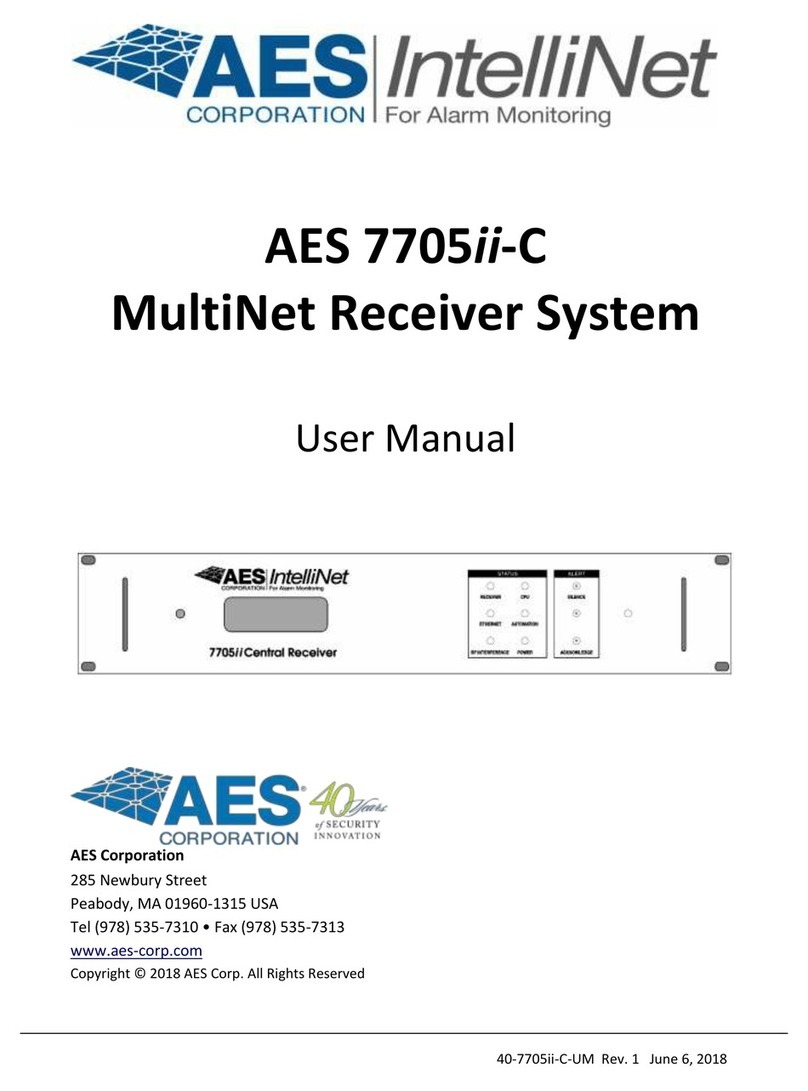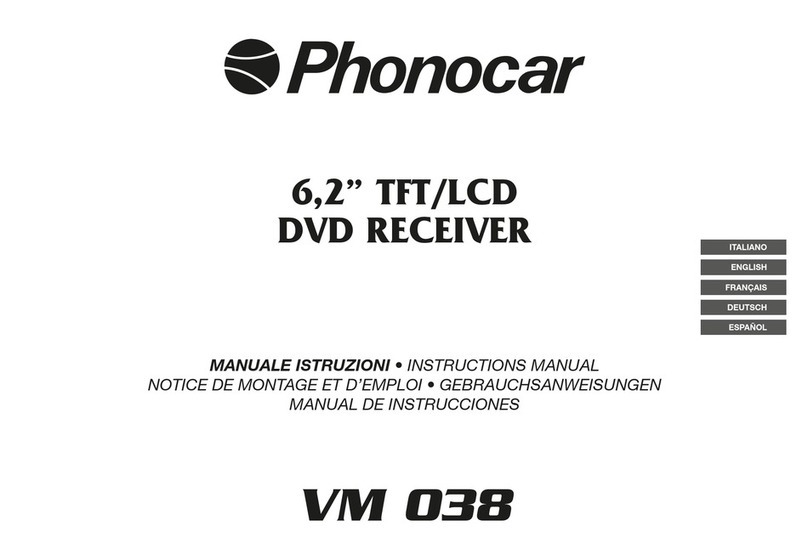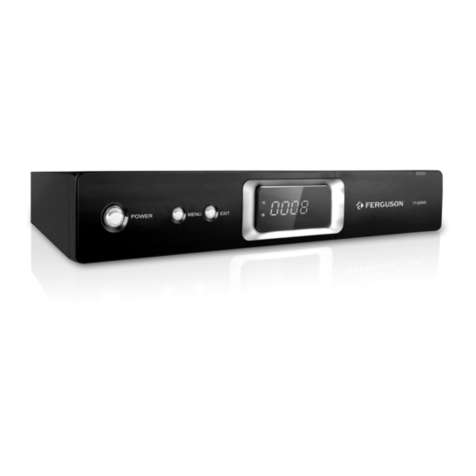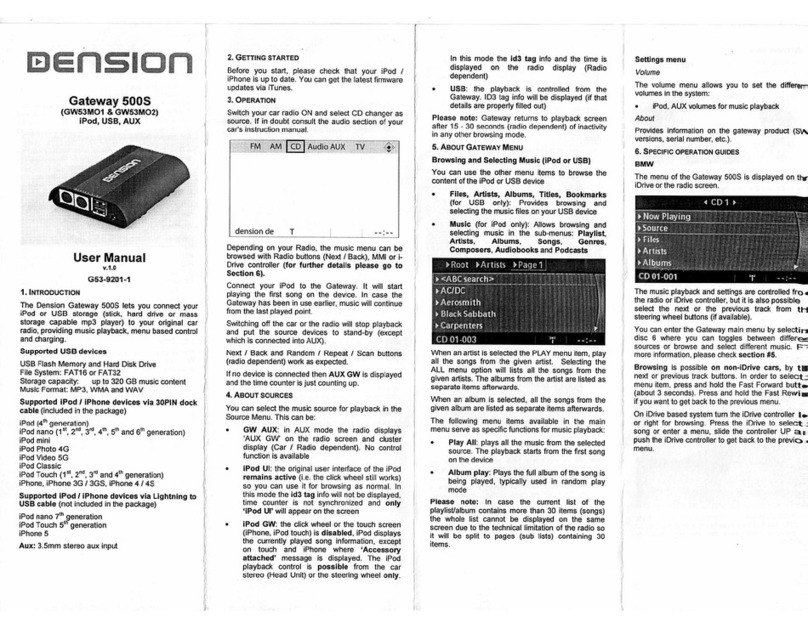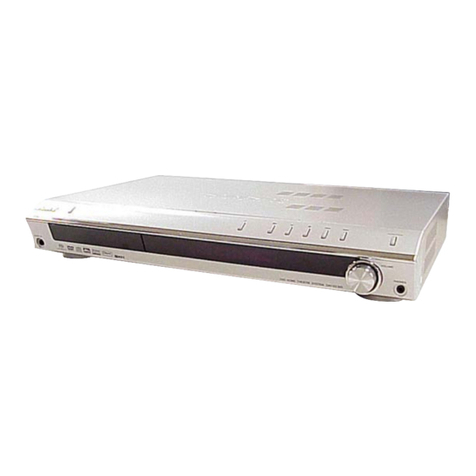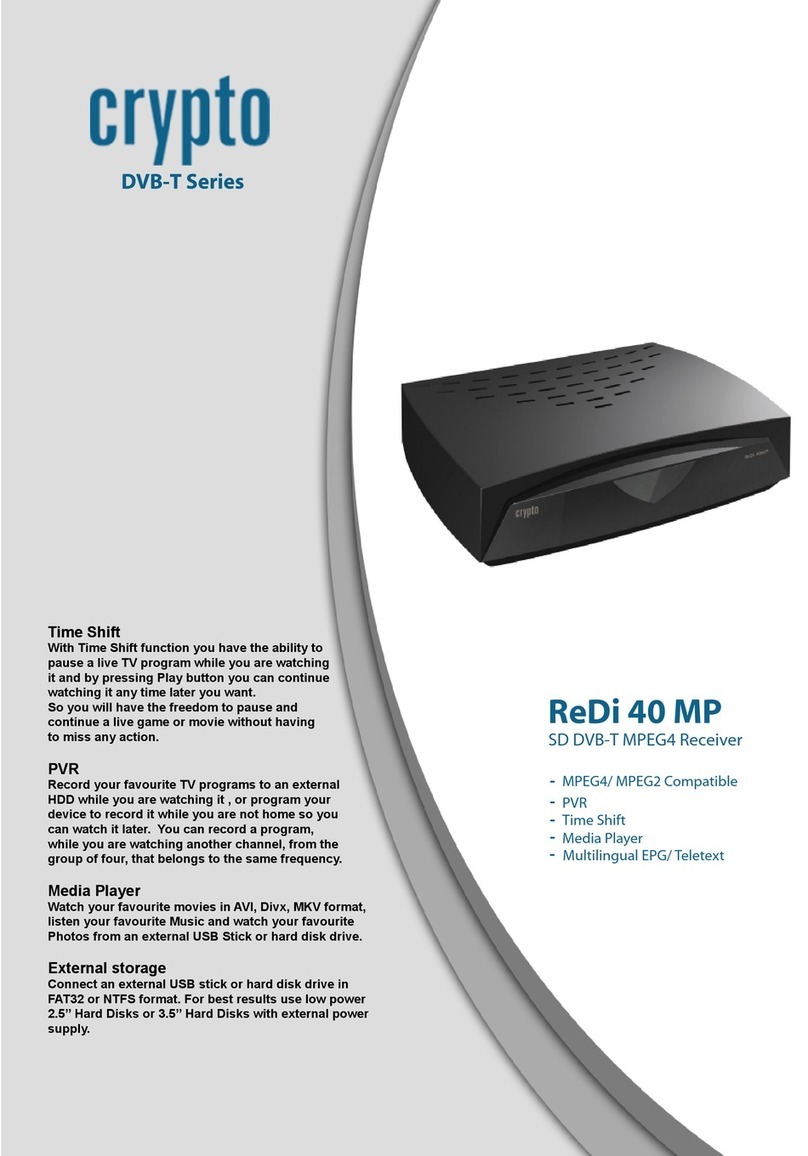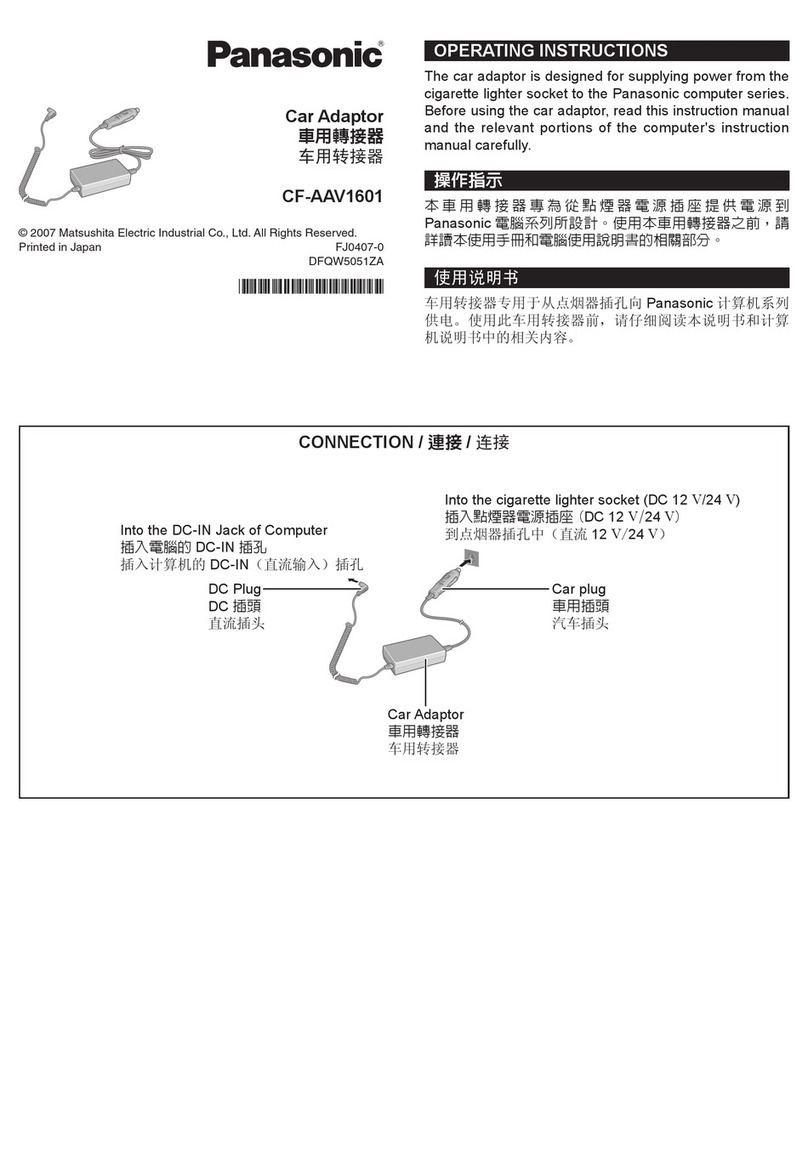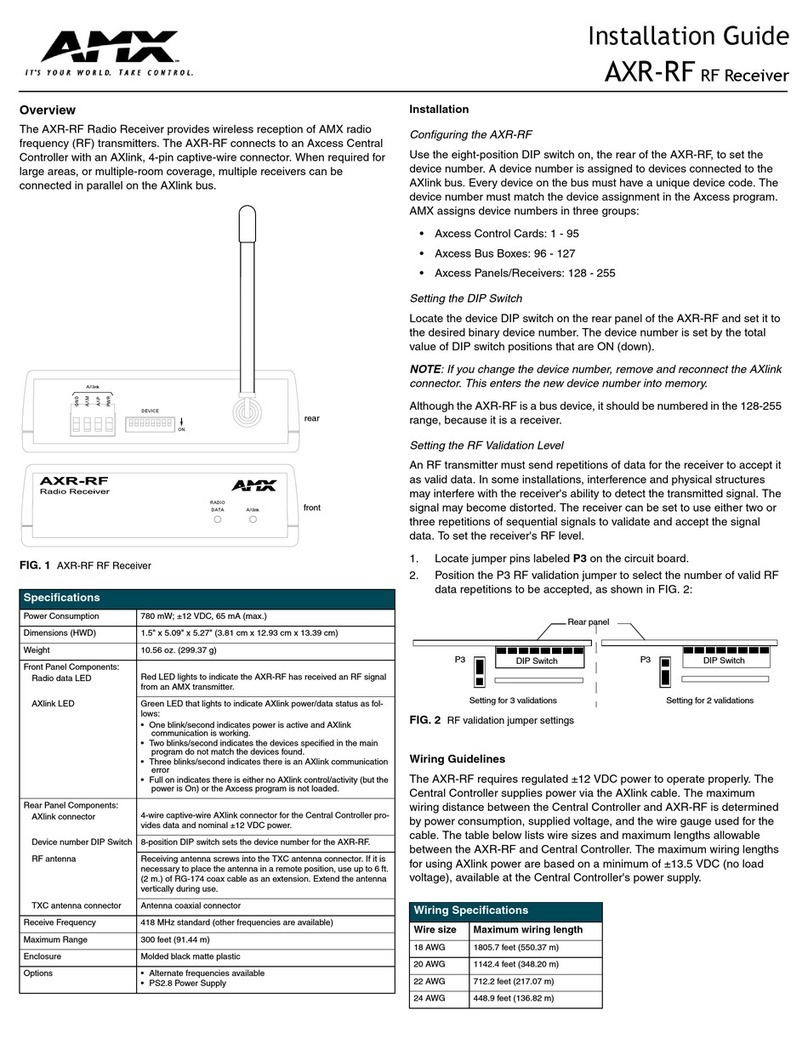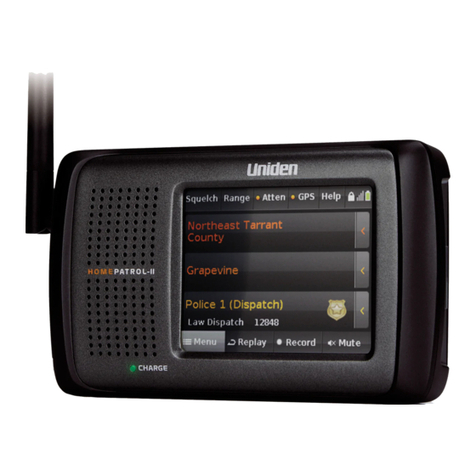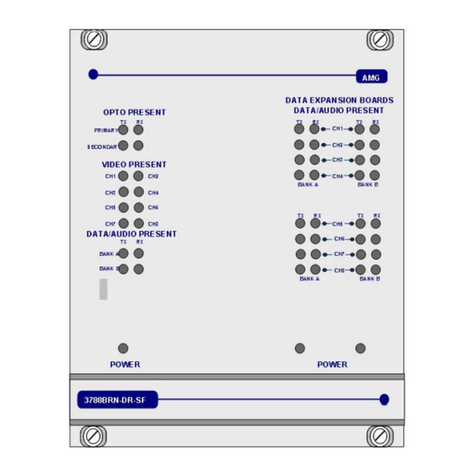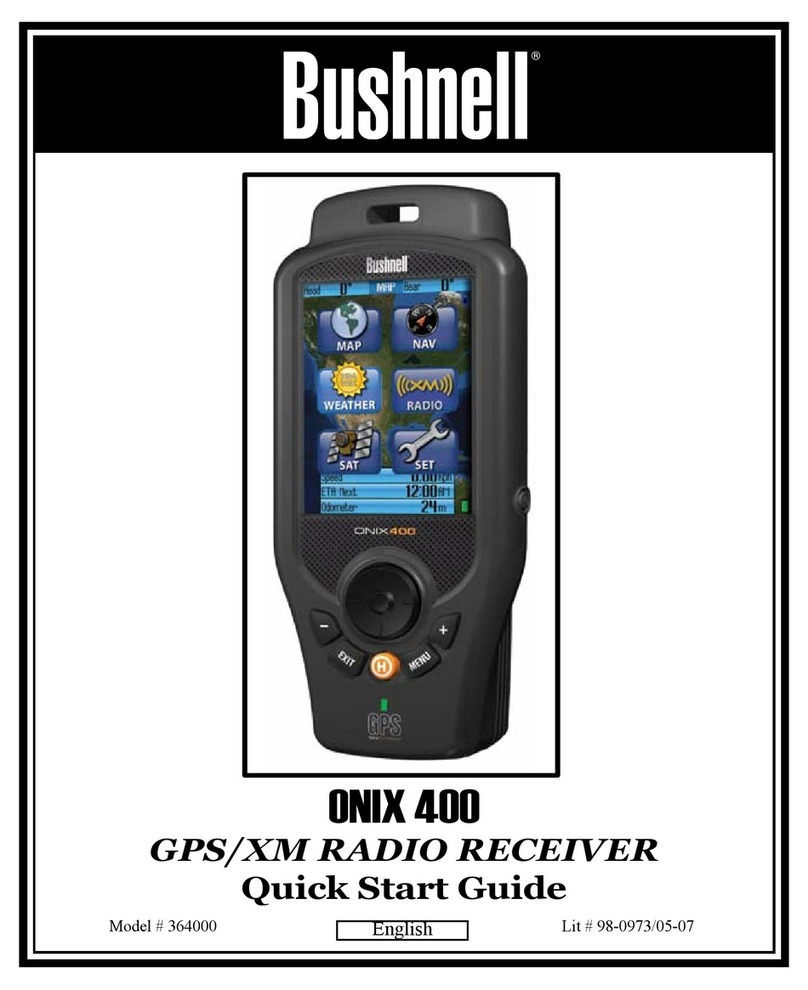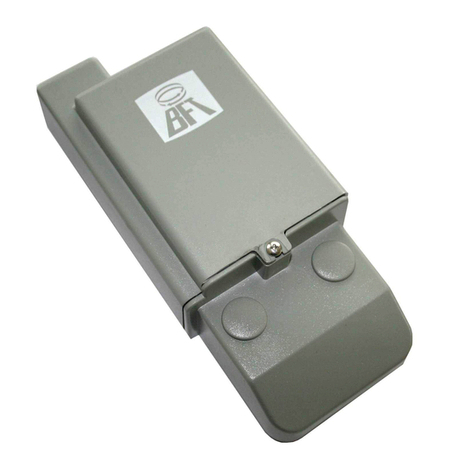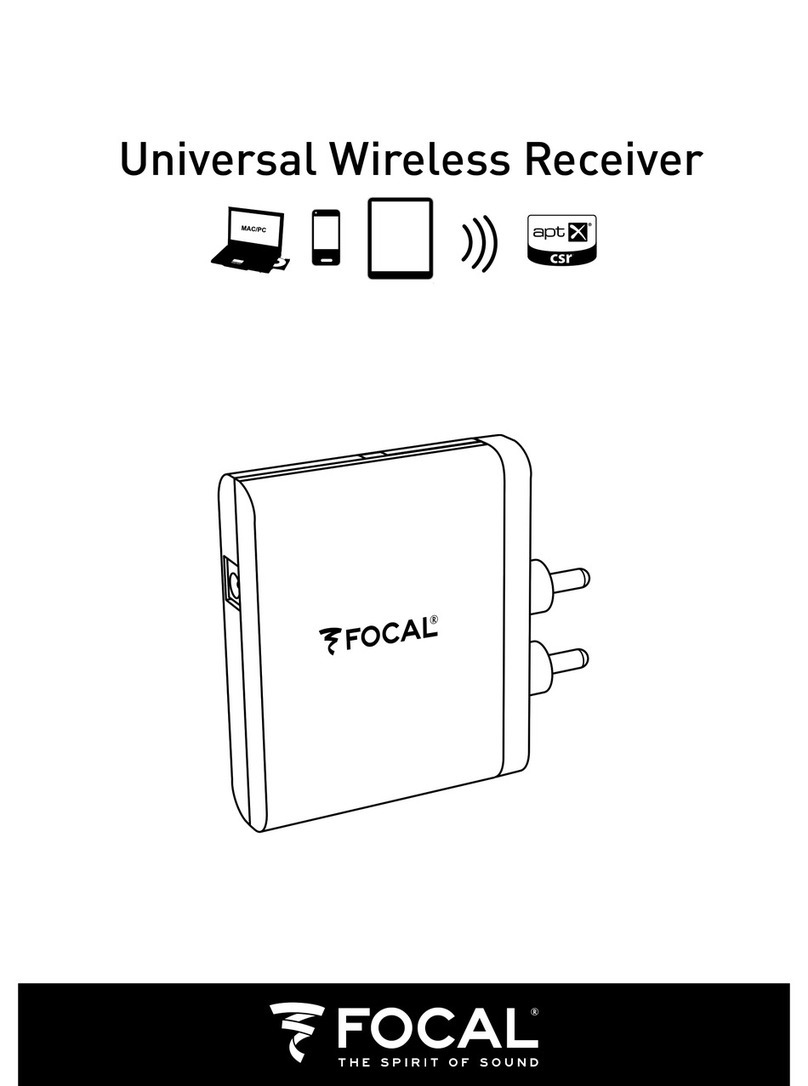AES Corporation IntelliNet 7705ii User manual

40-7705ii-UM Page 2 Rev. 1 June 11, 2018
NOTICE TO USERS, INSTALLERS, AUTHORITIES HAVING JURISDICTION, AND
OTHER INVOLVED PARTIES
This product incorporates field-programmable software. In order for the product to comply
with the requirements in the Standard for Control Units and Accessories for Fire Alarm Systems,
UL 864, certain programming features or options must be limited to specific values or not used
at all as indicated below.
Program Permitted in Possible
Feature or Option UL 864 (Y/N) settings Settings permitted in UL 864
Alarm Automation Y 0-90 As configured by UL 1981
Heartbeat Signal Central-Station Automation
Frequency: Systems Requirements
Serial or IP
Data Type: Y Security, GPS, USDI, Security
Others in pull down menu
Old Alarm Delivery Y All, Subscriber controlled
Options Never All
Radio Packet Life Y 0-99 0 –No Time Out for Alarm, Trouble or
Restoral
Software Version:
Instructions to view the software version are in Section 3.1.1 LCD Display and Software Version.
Notes:
1. For Alarm Automation references throughout this manual:
Alarm Automation output must be connected to a UL 1981 Listed Alarm Automation System
2. For UL Central Station Burglar Alarm applications:
Opening/Closing Signals shall be sent using an alternate communication means that provides for
premises acknowledgement (ring back)
3. This product shall be installed in accordance with NFPA 72, NEC,
UL 827 and all applicable local codes
4. For compliance with UL Central Station Burglar Alarm applications:
A computer workstation is required to be able to determine subscriber status. The workstation
shall be UL Listed ITE equipment.

40-7705ii-UM Page 3 Rev. 1 June 11, 2018
AES 7705ii MultiNet Receiver
Table of Contents
1.0 Product Description: .................................................................................................... 6
1.1 About AES IntelliNet: ........................................................................................... 6
1.2 MultiNet Receiver: ................................................................................................ 6
1.3 7170 IP-Link Transceivers:................................................................................... 7
1.4 Document Conventions: ........................................................................................ 7
2.0 Safety Considerations: ................................................................................................. 9
3.0 Technical Specifications:.............................................................................................. 9
3.1 Front Panel –Software Version: ......................................................................... 10
3.2 Rear Panel:........................................................................................................... 11
4.0 Installation and Setup :.............................................................................................. 14
4.1 Software Installation:................................................................................................. 15
5.0 System Startup and Access:....................................................................................... 19
5.1 1st Time Notes:..................................................................................................... 19
5.2 Power up:............................................................................................................. 19
5.3 Power Down - Information:................................................................................. 20
5.4 Local Access and Login: - Initial Setup .............................................................. 20
5.5 Linux Command line:.......................................................................................... 21
5.6 Common Linux Commands: ............................................................................... 21
5.7 The GUI Desktop and the AES Menu:................................................................ 22
5.8 Start the Terminal Program:................................................................................ 23
5.9 Setting Time: ....................................................................................................... 24
5.10 Synchronizing Time: ........................................................................................... 24
5.11 Time Zone: .......................................................................................................... 24
5.12 Review your TCP/IP Configuration:................................................................... 25
5.13 Factory Default TCP/IP Settings......................................................................... 25
5.14 Suggested TCP/IP Settings for Second MultiNet Receiver................................. 26
5.15 A note on DHCP.................................................................................................. 26
5.16 Configure TCP/IP, Linux Network Configuration:............................................. 26
5.17 Testing TCP/IP Configuration:............................................................................ 29
5.18 User Logout from directly attached keyboard & monitor:.................................. 30
5.19 User Logout from Workstation Access:.............................................................. 30

40-7705ii-UM Page 4 Rev. 1 June 11, 2018
6.0 Admin GUI for Configuration and Administration:............................................... 31
6.1 Server Configuration ........................................................................................... 33
6.2 Define Business Units: (you must have at least one) .......................................... 34
6.3 Add a Business Unit –Alarm Automation Settings............................................ 37
6.4 Business Unit Overview...................................................................................... 42
6.5 Modify a Business Unit....................................................................................... 43
6.6 Subscriber Database Setup .................................................................................. 44
6.7 Alarm Data .......................................................................................................... 47
6.8 Close Your Browser When Finished With Admin GUI:..................................... 48
7.0 Workstation Access and Login:................................................................................. 49
7.1 Programs for Access Via a Workstation.............................................................. 49
7.2 Installing VNC Viewer:....................................................................................... 50
7.3 Using VNC Viewer: ............................................................................................ 51
7.4 After login: .......................................................................................................... 52
8.0 MultiNet Receiver Programs and Utilities:.............................................................. 53
8.1 MultiNet Specific Programs:............................................................................... 53
8.2 MultiNet Utility Programs and Scripts:............................................................... 54
8.3 Special Purpose Circuits:..................................................................................... 56
8.4 AES Menu in the GUI Desktop:.......................................................................... 57
9.0 Managing Users:......................................................................................................... 58
9.1 Adding a user:...................................................................................................... 58
9.2 Retrieving user Display Number and Password:................................................. 58
9.3 Changing a user’s Password:............................................................................... 59
9.4 Change Admin GUI Access - Username and Password:..................................... 60
9.5 Deleting a User:................................................................................................... 60
9.6 Test new user login:............................................................................................. 61
10.0 Admin GUI Database Functions:.............................................................................. 62
10.1 Subscriber Overview ........................................................................................... 62
10.2 Routing Table Screen: ......................................................................................... 63
10.3 IP-Link Status Screen:......................................................................................... 64
10.4 Get Signal History:.............................................................................................. 64
10.5 Close Your Browser When Finished With Admin GUI:..................................... 65
11.0 IPLinkCtrl (ipctrl) Network Management Software:............................................. 66
11.1 IPCtrl Function Groups: ...................................................................................... 67

40-7705ii-UM Page 5 Rev. 1 June 11, 2018
11.2 Common data entry/selection menus and pop-ups:............................................. 67
11.3 Using the pick list pop up to Select a Subscriber ID........................................... 68
11.4 Selecting a Route for Communication with a Subscriber Unit ........................... 68
11.5 The Message Function Group: ............................................................................ 69
11.6 Control Function Group....................................................................................... 71
11.7 Programming Function Group:............................................................................ 74
11.8 Data Radio Function Group:................................................................................ 86
11.9 System Function Group....................................................................................... 90
11.10Interpreting Screen Messages.............................................................................. 91
12.0 Operation..................................................................................................................... 92
12.1 Manual Operation................................................................................................ 92
12.2 Automatic Operation ........................................................................................... 92
13.0 Warranty and Service Procedure:............................................................................ 93
APPENDICES.......................................................................................................................... 94
Appendix A Common Linux Commands .............................................................................. 95
Appendix B Server-generated LCD Display Messages. ....................................................... 96
Appendix C Software installation Instructions..................................................................... 98
Appendix D Sharing the Serial Port with additional Business Units.................................. 99
Appendix E Alarm Output Codes Produced by the MultiNet receiver............................ 101
Appendix F Printer Messages Produced by the MultiNet receiver................................... 111

40-7705ii-UM Page 6 Rev. 1 June 11, 2018
1.0 Product Description:
This document discusses the installation, configuration and use of the various programs
and hardware in the AES MultiNet Receiver uses. This Receiver is the heart of the
AES MultiNet system. All properly configured 7170 IP-Link Transceivers (see Section
1.4) will send their received AES IntelliNet packets to this Receiver via TCP/IP over a
LAN, WAN, the Internet or if necessary and equipped, via Modem (as backup), for
distribution to the appropriate application or external system.
1.1 About AES IntelliNet:
AES IntelliNet is a two-way data radio network for the monitoring of alarms or
transmission of specialized data packets. It is faster and more reliable than telephone
and cellular systems, which are subject to both tampering and general failure. Phone
lines may still be used for backup.
What makes the patented AES system unique are its “smart” radio communicators,
called subscriber units. Each subscriber unit is connected to an alarm panel or
specialized data port. Alarm information or data is transmitted by radio to the central
receiver or an “IP-Link Transceiver” (see Section 1.4). If a subscriber unit is too far
away to reach the central station or an IP-Link Transceiver directly, its message is
relayed by another subscriber unit closer to or in better communication with the central
station or other closer units. This unique built-in “repeater” capability creates a highly
rugged, adaptive security network. The system adjusts itself to forward messages by
the shortest and best available route. The “smart routing” capability is completely
automated, with no special programming needed. Also, by eliminating the need for
dedicated repeaters and towers, the AES system dramatically reduces the cost of setting
up and operating a wireless monitoring system.
1.2 MultiNet Receiver:
The AES 7705ii MultiNet Receiver with integrated PC, Linux operating system and IP-
Link programs is housed in a 19” rack mountable enclosure. This device acts as the
central receiver. It is a specialized Linux based server with specific programs running
that acquire data packets from one or more IP-Link Transceiver(s). AES Linux server
software reads subscriber data from these IP-Link transceivers via a TCP/IP socket
connection. The server programs categorize the incoming data and forward it to
customer systems for further processing. An example of this activity is alarm
processing, where the server software identifies an alarm received by an IP-Link, sent
by a Subscriber attached to an alarm panel, processes it, then forwards an alarm
message to a customer’s alarm automation software.
The software installation consists of several AES programs that process the data and a
web-based GUI for server administration and subscriber configuration. The AES
programs rely on open system components, including the Apache web server with php,
and the MySQL database, to process the subscriber data.

40-7705ii-UM Page 7 Rev. 1 June 11, 2018
Other programs in the MultiNet receiver evaluate and distribute the data to an
appropriate application on this machine or another located on the LAN, WAN or
Internet. These other applications may re-distribute the data, store it in a database for
later retrieval, send it out a local RS-232 serial COM port, send it out a printer port or
perform whatever function the application is designed. A single MultiNet Receiver can
have multiple IP-Link Transceivers installed locally or anywhere connected by a
TCP/IP connection. This capability allows the IntelliNet network to be expanded
virtually to any location desired that is serviced by the LAN, WAN or Internet.
1.3 7170 IP-Link Transceivers:
These units communicate to the MultiNet Receiver via a direct Ethernet connection,
LAN, WAN or the Internet. Models have an integrated Modem to communicate using
a phone line if the TCP/IP connection is down. The IP-Link acts much like a subscriber
that re-transmits its received data packets via the TCP/IP connection rather than via an
RF transmission. This allows the IP-Link Transceiver to be located outside of RF
communication with a central station receiver and the expansion of the IntelliNet
system into previously unreachable locations. They should be installed with the same
care that a central station receiver would as they are usually the primary path to the
central receiver location. Multiple IP-Link Transceivers can be installed in a single RF
cloud to act as backup or to provide multiple paths for subscribers in a geographical
area. Each IP-Link Transceiver can operate at the same frequency or at another.
Operating at other frequencies allows for an overcrowded region to get a new clear
frequency and still be able to be managed by the same receiver. It also allows the
expansion into other regions, states, countries or islands where regulations may require
operation at a different frequency than your other IP-Link Transceivers.
1.4 Document Conventions:
<Key> Characters between angled brackets refer to a specific key on the
keyboard.
Example <Enter> means to press the Enter Key.
{variable} Characters between these braces refer to a value that will vary dependent
on any number of circumstances or configurations.
Example: {username} means to replace {username} with the
appropriate user name.
Example 2: {IP Address} would require a valid IP address be typed in
place of the label.
[Screen Text] Square brackets have several uses. Occasionally refers to a Graphical
Button, usually selected by clicking on the screen graphic.
Also used to indicate a selection available by choosing from an available
list.
May also be used to show actual characters displayed.

40-7705ii-UM Page 8 Rev. 1 June 11, 2018
Typical MultiNet System
It is highly recommended and required for UL systems that a redundant MultiNet Receiver be
operational at the head end and that any location of 7170 IP-Link Transceivers have at least
two for the purposes of redundancy.

40-7705ii-UM Page 9 Rev. 1 June 11, 2018
2.0 Safety Considerations:
All equipment must be installed in accordance with National Electric Code, applicable
UL Standards and local building codes. No user serviceable parts. Do not open
enclosure. Unplug power before installing or removing unit.
3.0 Technical Specifications:
The 7705ii is in a standard 2U 19” rack enclosure configuration.
Operating voltage: 120 VAC, 60 Hz. +/- 10%
Operating current: 0.6 Amps
Operating Temperature Range: 13° to 35° +/-2 °C
55° to 95° +/-3 °F
Storage temperature Range: -10° to 60° C
4° to 140° F
Power Consumption: 200-Watts Maximum
Physical Dimensions: 19” Wide x 3.5” High (2U) x 12.24” Deep
(13.25” including rack handles)
Minimum Rack Depth: Approximately 16” to allow for cables
and connectors.
Weight: 9 pounds (approximate)
Encryption: AES 128 Bit

40-7705ii-UM Page 10 Rev. 1 June 11, 2018
Figure 3-2
3.1 Front Panel –Software Version:
The front panel has the user display and controls. Figure 3-1 shows a view of the front
panel.
Figure 3-1
3.1.1 LCD Display and Software Version: The LCD is a 4-line display with 20
characters per line. It shows messages for the 7705ii. Use this in conjunction with the
Alert panel to interpret and acknowledge messages. There is also a tactile response
sounder to provide audible confirmation of a successful button activation.
In most modes of operation, the top line will be constant and display the software
version number and AES copyright.
Example:
Other lines will be used to display messages generated by the server. Refer to
Appendix B for a detailed explanation of server-generated messages displayed on the
LCD.
3.1.2 Status Panel: Contains LEDs that indicate fault
conditions as described below: See Figure 3-2.
When any of the Status LEDs are activated to reflect a
failure, the LED on the Alert panel will also be
activated, causing the Alert Sounder to activate.
Pressing SILENCE will momentarily silence the Alert
Sounder for 30 seconds until message is cleared.
Pressing ACKNOWLEDGE will clear the Alert LED.
The status LED will not be “cleared” until the failure
has been corrected.
Receiver: Red Led - Indicates a hardware or
system fault in the server. These faults will
include Printer Offline and LCD display faults.
CPU: Red Led - Indicates that the CPU or internal processor has performed a
reset either manually initiated or automatically by the internal watchdog circuit.
Pressing the Acknowledge button turns off this LED.
Ethernet: Red Led - Indicates a fault condition with the Ethernet connection as
detected by a missing check-in from a 7170 IP-Link Transceiver.
Automation: Red Led - Indicates that the Alarm Automation process is unable
to get Acknowledgements from a designated alarm monitoring system.
REV #.## (C) 2005-06 AES

40-7705ii-UM Page 11 Rev. 1 June 11, 2018
Figure 3-3
RF Interference: Red Led - Indicates that an RF interference condition exists
and that signals may be hindered. RF interference is a condition where the
Carrier Detect (CD) in the transceiver is active for more than 20 seconds. This
LED will turn off if CD turns off for 100 milliseconds.
Power: Green Led - Indicates that proper power is detected at the monitored
points within the 7705ii.
3.1.3 Alert Panel: This section of the front panel contains an LED and two Push
Button Switches. The LED illuminates to indicate the existence of unacknowledged
message(s). The switches allow for Silencing and Acknowledgment as described
below: See Figure 3-3. There is also an audio device associated with these functions,
which is located behind the small hole to the right of the Alert Panel.
A message queue exists within the MultiNet receiver to hold messages that are in need
of a user’s response. A user must acknowledge these messages manually when alarm
automation is offline and that automation system is not acknowledging the reception of
those messages using the configured communication protocol.
Tactile Response Sounder:A short beep sound will be heard from the tactile
response sounder located near the LCD any time a button press in this panel is
accepted. There may be a short delay between the press and the sounder’s beep.
Silence Button: Is used to silence the internal alert sounder. Note: The
Silence button when held down for a minimum of 5 seconds will start the
LCD test and LCD lamp test sequence.
If the Silence Button does not silence the Alert Sounder, it may be due to an
overheating condition. Other MultiNet Receiver functions may appear normal. The
unit must be shut down and the cause of the overheating condition must be corrected
before continued use. To shut down the unit, switch the power switch on the rear panel
to the Off position. Contact AES for service
Alert LED: Red Led - Indicates that a condition
exists that needs attention or that the CPU LED is on.
Refer to the Alert messages on the LCD display for
details.
Acknowledge Button: Is used to Acknowledge the
message that is currently displayed on the LCD
Display. This is a function that is only required when
automation is offline. Once acknowledged the current
message is removed and the next message (if any) in
the message queue is displayed.
When alarm automation is online, pressing this button will turn an illuminated
Alert LED off.
3.2 Rear Panel:
The rear panel contains the connectors used to attach external connections, peripherals
such as the monitor, keyboard, mouse and power. The main power switch is also
located on the rear panel. The rear panel is divided into sections as outlined below.
Figure 3-4 shows a view of the rear panel.

40-7705ii-UM Page 12 Rev. 1 June 11, 2018
Figure 3-4
3.2.1 Power Section: Contains the power input connector and power supply On/Off
switch as described below: Also contains the Power Supply fan.
Power input connector: Plug the female end of the supplied AC power cord
into this connector and the male end of the power cord into a
120 VAC, 60 Hz receptacle supervised by a UL Listed UPS or a UL 1481
power supply.
Do not connect to a receptacle controlled by a switch.
Power On/Off switch: This switch controls the internal power supply. When
in the off ( O ) position power supply output is interrupted. When in the On (|)
power is provided to the internal electronics including the motherboard.
Power Supply Fan: This fan must be kept clear of obstructions to permit
unobstructed flow of air.
3.2.2 Modem Section: Contains a single telephone jack connector:
Phone line/Modem Jack: Plug a telephone cord into this connector with the
other end plugged into an active telephone Jack. This is used to provide a
backup Modem connection for IP-Link Transceivers that cannot communicate
via the Internet or TCP/IP.
When connecting the 7705ii MultiNet Receiver’s modem to a telephone line, use only 26
AWG or larger wire. A UL Listed 497A Secondary Protector is required to be installed on the
incoming lines. Installation shall be in accordance with the NEC Article 800, the manufactures
installation instructions and in accordance with all local codes.
Power Section Modem Single Board Computer Connection Section

40-7705ii-UM Page 13 Rev. 1 June 11, 2018
3.2.3 Single Board Computer Connector Section: Contains connectors for computer
peripherals.
Serial Port 1 / (COM 1): [/dev/ttyS1] Used to connect to alarm monitoring system
for signals communicated via RS-232.
See Appendix E for a list of Alarm messages generated.
Serial Port 2 /(COM 2): Not used.
Monitor, CRT (VGA): Connect a video monitor for initial configuration.
Ethernet Port 1 [ENET1]: Can be used for a dedicated crossover Ethernet cable
connection to a 7170 IP-Link transceiver using no additional network hardware or
as a connection to an Ethernet Hub/Switch using a standard straight through
Ethernet cable.
Pre-configured factory default to static IP address 192.168.0.101.
Ethernet Port 2 [ENET2]: Not used.
HDMI: Not used.
USB:
oFor initial receiver configuration connect a keyboard and a mouse to USB ports.
Once configured, access to the MultiNet Receiver is done through a computer
workstation connected by network through ENET1.
oLine printer is connected to a USB port. The printer needs to be UL-864 listed for
“Signaling Use”.
.
See Appendix F for a listing of generated messages.
Note: These are to be used for initial setup only and are not to remain
connected.

40-7705ii-UM Page 14 Rev. 1 June 11, 2018
4.0 Installation and Setup :
A separate “Initial Installation and Setup Guide” is provided to guide
you through the initial installation and setup.
A standalone Receiver requires a monitor, keyboard and mouse for user interface. See
Figure 4-1. The standalone configuration is not recommended by AES Corporation for
anything other than initial setup and preliminary testing of the system. Once properly
configured and connected to a LAN, a network workstation is used to access and
configure the receiver remotely. See Figure 4-2 and Figure 4-3.
A printer is also required for printing any output directed to the printer port. Refer to
Appendix F for a listing of printed messages. Ethernet port(s) are integrated into the
PC and are used to connect to the IP-Link Transceiver(s) and external applications on
remote servers or systems via direct connection, LAN, WAN or the Internet.
A system, while it may not have a keyboard, video monitor or mouse connected
during normal operation, will require these peripherals connected directly for
initial setup until remote access is accomplished. They may also be needed later
for occasional configuration modifications.
The 7705ii, monitor and any network related equipment shall be connected to a suitable
UL-UPS to maintain power during power outages.
In a Dual system, each 7705ii and the 7170 IP-Link Transceiver shipped, is configured
exactly the same. At least one set must be modified to operate the two pairs together in
the same TCP/IP network. Each device in the system must have unique TCP/IP
addresses. Each 7170 must have a unique Unit ID for the IntelliNet Network it will
operate in.
Figures 4-1, 4-2 & 4-3 on next pages illustrate some typical system installations. The
illustration on page 8 also illustrates a typical system.

40-7705ii-UM Page 15 Rev. 1 June 11, 2018
Notes:
Power Line, router/ switch, and telephone connections shall not leave the room
where the AES equipment is installed. This must be accomplished by co-
locating outlets and interfacing equipment in the room where AES equipment
resides.
7705ii must be installed in a UL Listed metal rack-mounting cabinet that
complies with UL-60950 standard for IT equipment. The rack mount cabinet
must be provided with integral outlets and the ability to connect AC input via
conduit. All wiring exiting the cabinet must be in electrical conduit. Be sure
non-power limited and power limited wiring are separated by at least 1/4 inch.
All equipment shall be connected to a UL Listed UPS (UL 864) or UL 1481
power supply. In addition, the central station shall have a generator to
maintain power for the receiving equipment and environmental controls for a
period up to 24 hours or longer.
A UL Listed UPS or generator to supply 24 hours of standby must be installed
and utilized at the monitoring station. If the primary power source at the
monitoring station is lost or otherwise faulted, this condition must be obvious
to the operator on duty.
Equipment Location: A UL 7705ii MultiNet Receiver must be installed in a
room where operators can properly hear the Audio Alert Sounder.
When connecting the 7705ii MultiNet Receiver’s modem to a telephone line, a
UL 497A Secondary Protector is required to be installed on the incoming lines.
Installation shall be in accordance with the NEC Article 800, the
manufacturers installation instructions and in accordance with all local codes.
When connecting the 7705ii MultiNet Receiver’s Ethernet ports to a network,
a UL 497B Secondary Protector is required to be installed on the Ethernet
cable. Installation shall be in accordance with the NEC Article 800, the
manufactures installation instructions and in accordance with all local codes.
4.1 Software Installation:
All necessary software is pre-installed on your 7705ii.
If your system has a catastrophic failure it may require the reinstallation of the Linux
operating system and the specialized IP-Link software programs. BIOS settings should
also be checked to confirm that the unit would initialize and operate properly. Routine
backing up of the databases to another storage device would be essential in any
successful reinstallation or recovery process.
Contact AES Technical Support if you need assistance with software installation or
BIOS settings.

40-7705ii-UM Page 16 Rev. 1 June 11, 2018
Figure 4-1
Single MultiNet Receiver Connections to a 7170 for Initial Setup

40-7705ii-UM Page 17 Rev. 1 June 11, 2018
Figure 4-2
Dual MultiNet Receiver Connections to Remote 7170 IP-Links thru Local Network

40-7705ii-UM Page 18 Rev. 1 June 11, 2018
Figure 4-3
Dual MultiNet Receiver Connections to Remote 7170 IP-Links thru Internet

40-7705ii-UM Page 19 Rev. 1 June 11, 2018
5.0 System Startup and Access:
AES ships the 7705ii MultiNet Receiver with the Linux operating system and IP-Link
programs pre-installed and with basic configuration already complete to operate as
shown in Figure 4-1. Each installation will have site-specific parameters that would
typically be changed or entered during initial installation and setup.
Refer to separate guide for assistance with initial setup.
Familiarity with the Linux operating system will be necessary to run programs that
operate, control and configure your IP-Link system. Refer to Appendix A for a list of
some common Linux commands you might use in this process.
5.1 1st Time Notes:
The first time that the MultiNet Receiver is powered up, it will require some
configuration specific to the unique installation environment in which it is to be used.
A directly attached keyboard, monitor and mouse will be needed to perform this
configuration. Refer to separate Initial Installation and Setup Guide. Do not connect
the Ethernet ports to an active network until you are confident the TCP/IP settings are
appropriate for the target network.
5.2 Power up:
If this is a standalone system, or if you are still configured for initial setup as shown on
Figure 4-1 with an attached keyboard, monitor and mouse, turn on power of the
attached video monitor.
Switch the power of the 7705ii to the on position. The main switch for the power
supply is on the back panel. This must be switched to on first.
Once the startup process has begun, the 7705ii MultiNet Receiver will initialize, going
through its normal boot sequence executing the programs defined in the configuration
files. Password protected remote access through VNC is factory configured. Web
access to the Admin GUI, which is an html-based interface, should be available after a
proper startup, assuming the network settings are properly configured for the receiver’s
attached network.
Power Switch - Rear Panel of Receiver

40-7705ii-UM Page 20 Rev. 1 June 11, 2018
5.3 Power Down - Information:
The power to the 7705ii should not just be removed without going through the proper
shut down procedure.
DO NOT REMOVE POWER OR TURN OFF POWER of the 7705ii MultiNet
Receiver WITHOUT USING THE PROPER SHUT DOWN PROCEDURE!
This receiver is a Linux server and improper shut down could damage files and prevent
operation. There are several ways to shut down a Linux server. Linux provides a
command named “shutdown” to perform this function.
● To shut down a MultiNet receiver, enter the following command from a command
line prompt:
shutdown –h now<Enter> Or
● To shut down a MultiNet receiver from the GUI, right click on the desktop and select
“Shutdown Server!”
5.4 Local Access and Login: - Initial Setup
Local access means to operate the MultiNet Receiver using a keyboard, monitor and
mouse that are connected directly to the back of the Receiver. Login is required to
operate the Receiver in this manner.
After a successful power-up, you should be presented with the login prompt “aes
login:” You may have to press <Enter> after the boot up process to get the actual login
prompt. Note the lines at the top of the display in Figure 5-1. They are typically the
last lines seen before the login prompt on the display for a normal boot up. Press
<Enter> after these lines are displayed if the “aes login” is not displayed. For Super
user Administrator functions you need to login as root using the current password. The
factory default password for user root is peabody2.
At the “aes login” prompt, type
root<Enter> then
peabody2<Enter>.
Note: After initial setup, if the password has been changed, as it should be, use the
current password for user root to login to perform setup and configuration
functions.
○Be sure to log out when finished. See “User Logout”
○The user root is the most powerful Super user in a Linux server.
Do not leave the system unattended when logged in as root!
○User root should only be used to perform administrative functions!
○To prevent unauthorized access –change default passwords as
described in “Managing Users”, section 9.
When the startup and login process is complete, you should be presented with the
command prompt “[root@aes root]#”. See Figure 5-1 below. Enter key may need to be
pressed before the prompt is actually displayed.
Table of contents
Other AES Corporation Receiver manuals

